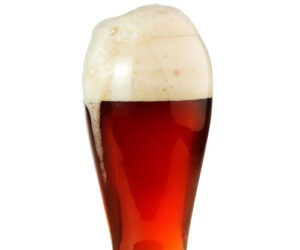Golden Ale
Golden ale, blonde ale, Canadian ale. No matter what you call it, you’re describing the beer we’re brewing in June. The name may be a bit fuzzy, but the beer is usually an all-malt ale that’s light and dry. It resembles a light lager, with greater bitterness and hop flavor. It’s also similar to pale ale, but it’s lighter in color in body.
For starters, sample some commercial golden ales to get a feel for the style. Goose Island Blonde, made by Goose Island Brewing in Chicago, won a gold medal at last year’s Great American Beer Festival. It’s a great one to try; Goose Island beers are gods, in my opinion. Still, my favorite American golden is probably Full Sail Golden Ale, brewed by Full Sail Brewing Company in Hood River, Oregon. It has a nice clear appearance, mild hopping and a dry finish.
From Canada, try Warthog Ale from the Big Rock Brewing Company in Calgary, Alberta. And even though it’s brewed Down Under, Cooper’s Sparkling Ale, made by Cooper’s Brewery in South Australia, is another prime example of a Canadian golden. It’s a classic light ale, pale and crisp with a subdued hops presence. It’s highly carbonated and tastes great ice-cold.
By the numbers, here’s how golden ales come together. The original gravity ranges from 1.044 to 1.056 (11° to 14° Plato); the alcohol by volume is between 4 and 5 percent; the bitterness falls between 15 to 30 IBUs; and the color is 3 to 10 SRM. By way of commercial comparison, Foster’s Lager is approximately 4 SRM (for more information, see “The 411 on SRM,” page 21).
To brew this month’s golden ale, we’ll use a standard two-row malt and a little bit of crystal malt (10° Lovibond or as light as you can get). The mash will be a standard single infusion, at 149° F.
Many brewers mash at temperatures higher than the 149° or 150° F that I recommend. It’s well known that the alpha-amylase enzyme works best at slightly higher temperatures, sometimes known as the “conversion temperature.” This varies depending on the source consulted, but is usually between 158° and 161° F. That’s too hot for beta amylase activity, a very important step in breaking down complex starches during the mash. The beta amylase enzyme is most effective from 140° to 149° F.
At 149° F, the alpha is not in its optimum range and the beta is at the high end of its optimum range. Still, both enzymes are active at this compromise temperature.
Also, beta amylase is a much stronger maltose producer than alpha amylase. This means that the 149° F temperature produces the most converted mash, and subsequently the most fermentable wort. Higher temperatures tend to produce a more dextrous wort, higher in body but lower in overall fermentability. So I always include a bit of dextrin malt, like carapils, for good measure.
Dr. Michael Lewis, a renowned (and now retired) professor from the University of California at Davis, described this “compromise” mash to me when I happened to meet him a few years back. I’ve stuck with it ever since,with great results.
Mildly bittering, aromatic, American hop varieties work well for this refreshing style of beer. Cascade, Mount Hood, Willamette and Liberty are great choices. You could also try Crystal, a great aroma variety with about 4 percent alpha acid. The timing for the hop additions are 90 minutes (beginning of boil), 30 minutes and 0 minutes (end of boil). Flower hops are best for this particular beer. They add a freshness that can’t be denied.
The fermentation schedule is standard, with a seven-day primary and secondary. This beer should not be estery, or fruity, so watch your fermentation temperature. Try to keep it at 68° F, because higher temperatures mean more esters.
Golden ale
(5 gallons, all grain)
Ingredients
• 7.5 lbs. pale malt
• 0.5 lbs. carapils
• 1.0 lb. crystal malt (10° Lovibond)
• 1.0 oz. of 4.5% alpha-acid Liberty hops (4.5 AAUs)
• 0.75 oz. of 4.5% alpha-acid Liberty hops (3.4 AAUs)
• 0.75 oz. of 4.5% alpha-acid Liberty hops (3.4 AAUs)
• 1 pt. starter of American ale yeast (Wyeast 1056 or equivalent)
• 2/3 cup corn sugar for priming
Step by Step
Mash grain in 3 gal. of water at 150° F for 60 minutes. Sparge with 168 to 170° F water to collect 5.75 gallons of wort. Total boil time is 90 minutes. At beginning of boil add first Liberty hops and boil 60 minutes. Add the second Liberty, boil 30 more minutes. At end of boil, add final Liberty hops. Whirlpool and cool to 68° F to pitch starter. Oxygenate-aerate well.
Ferment at 68° F for 7 days, transfer to secondary and ferment at 68° F for 7 more days or until gravity is about 1.008 (2° Plato) and fermentation stops. Rack, prime and bottle. Condition at 45° F (in the refrigerator) for two to three weeks. If the carbonation is insufficient, due to inactive yeast at the cooler temperature, leave the beer at room temperature for a day, then rechill before drinking.
Extract with grain option:
Substitute the pale malt with 6.5 lbs. pale malt extract syrup. Increase the first hop addition to 1.25 oz. Liberty.
Start with 5 gallons of 150° F water. Steep crushed grain for 30 minutes. Sparge grains with enough 170° F water to make 5.5 gallons. Heat to boiling and add extract syrup. Total boil will be 60 minutes. At beginning of boil add Liberty hops and boil 30 minutes. Add the second Liberty, boil 30 more minutes and add final Liberty. Whirlpool and cool to 68° F to pitch starter. Oxygenate-aerate well. Follow fermentation schedule for all-grain version.
OG = 1.052
FG = 1.012
Color = 6 SRM
Bitterness = 30 IBUs



